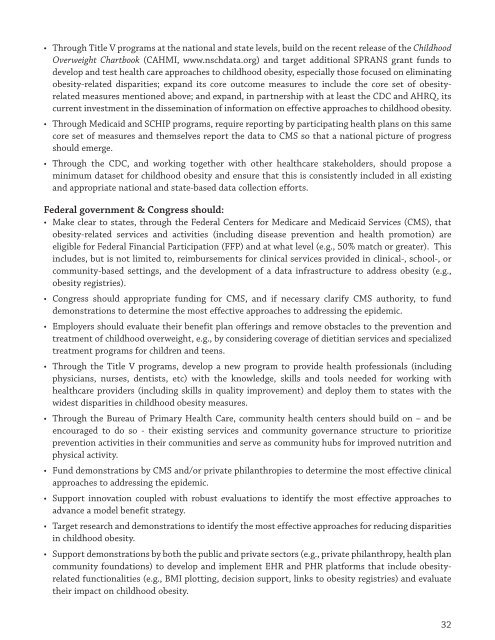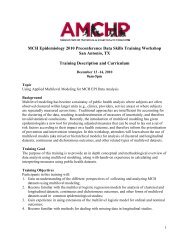Childhood Obesity: The Role of Health Policy - Association of ...
Childhood Obesity: The Role of Health Policy - Association of ...
Childhood Obesity: The Role of Health Policy - Association of ...
You also want an ePaper? Increase the reach of your titles
YUMPU automatically turns print PDFs into web optimized ePapers that Google loves.
• Through Title V programs at the national and state levels, build on the recent release <strong>of</strong> the <strong>Childhood</strong><br />
Overweight Chartbook (CAHMI, www.nschdata.org) and target additional SPRANS grant funds to<br />
develop and test health care approaches to childhood obesity, especially those focused on eliminating<br />
obesity-related disparities; expand its core outcome measures to include the core set <strong>of</strong> obesityrelated<br />
measures mentioned above; and expand, in partnership with at least the CDC and AHRQ, its<br />
current investment in the dissemination <strong>of</strong> information on effective approaches to childhood obesity.<br />
• Through Medicaid and SCHIP programs, require reporting by participating health plans on this same<br />
core set <strong>of</strong> measures and themselves report the data to CMS so that a national picture <strong>of</strong> progress<br />
should emerge.<br />
• Through the CDC, and working together with other healthcare stakeholders, should propose a<br />
minimum dataset for childhood obesity and ensure that this is consistently included in all existing<br />
and appropriate national and state-based data collection efforts.<br />
Federal government & Congress should:<br />
• Make clear to states, through the Federal Centers for Medicare and Medicaid Services (CMS), that<br />
obesity-related services and activities (including disease prevention and health promotion) are<br />
eligible for Federal Financial Participation (FFP) and at what level (e.g., 50% match or greater). This<br />
includes, but is not limited to, reimbursements for clinical services provided in clinical-, school-, or<br />
community-based settings, and the development <strong>of</strong> a data infrastructure to address obesity (e.g.,<br />
obesity registries).<br />
• Congress should appropriate funding for CMS, and if necessary clarify CMS authority, to fund<br />
demonstrations to determine the most effective approaches to addressing the epidemic.<br />
• Employers should evaluate their benefit plan <strong>of</strong>ferings and remove obstacles to the prevention and<br />
treatment <strong>of</strong> childhood overweight, e.g., by considering coverage <strong>of</strong> dietitian services and specialized<br />
treatment programs for children and teens.<br />
• Through the Title V programs, develop a new program to provide health pr<strong>of</strong>essionals (including<br />
physicians, nurses, dentists, etc) with the knowledge, skills and tools needed for working with<br />
healthcare providers (including skills in quality improvement) and deploy them to states with the<br />
widest disparities in childhood obesity measures.<br />
• Through the Bureau <strong>of</strong> Primary <strong>Health</strong> Care, community health centers should build on – and be<br />
encouraged to do so - their existing services and community governance structure to prioritize<br />
prevention activities in their communities and serve as community hubs for improved nutrition and<br />
physical activity.<br />
• Fund demonstrations by CMS and/or private philanthropies to determine the most effective clinical<br />
approaches to addressing the epidemic.<br />
• Support innovation coupled with robust evaluations to identify the most effective approaches to<br />
advance a model benefit strategy.<br />
• Target research and demonstrations to identify the most effective approaches for reducing disparities<br />
in childhood obesity.<br />
• Support demonstrations by both the public and private sectors (e.g., private philanthropy, health plan<br />
community foundations) to develop and implement EHR and PHR platforms that include obesityrelated<br />
functionalities (e.g., BMI plotting, decision support, links to obesity registries) and evaluate<br />
their impact on childhood obesity.<br />
32



